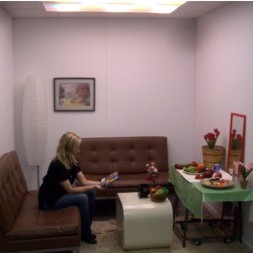Technical Activities Report
|
Strategic Elements:
|
Optical radiation standards
The Optical Technology Division provides the optical radiation measurement science and standards to aid the advancement and application of optical technology. In particular, the Division advances, maintains, and disseminates standards for the candela and kelvin base SI units, and associated photometric, colorimetric, pyrometric, and spectral radiometric quantities. These standards benefit industries from aerospace to lighting, by ensuring the accuracy and consistency of measurements within organizations and across national boundaries.
Research programs in the Division strive to continually improve the accuracy of our Nation’s radiometric and photometric scales to meet the demands of industry, government, and academia. These scales are increasingly being based on stable, low-noise, highly linear detectors, radiometers, and photometers. The absolute responsivities of these instruments are tied to optical power measurements performed using cryogenic radiometry and a state-of-the-art laser facility, SIRCUS (Spectral Irradiance and Radiance Calibrations with Uniform Sources). Cryogenic radiometry provides the highest accuracy optical power measurements by performing a direct comparison of optical and electrical power. The Division’s Primary Optical Watt Radiometer (POWR), the Nation’s standard for optical power, achieves a relative standard uncertainty of approximately 0.01 %.
The improvements realized by tying the radiometric measurements to cryogenic radiometry are significant. Linking of the Division’s spectral irradiance scale, as disseminated by FEL-type lamps, to POWR measurements has enabled the reduction of spectral irradiance uncertainties by a factor of two in the ultraviolet and visible, and even more in the infrared. The spectral radiance and radiance-temperature scales are similarly being tied to cryogenic radiometry. Because of the Division’s success in this area, the spectral irradiance scales for many nations are traceable to NIST standards.
These advances in detector-based radiometry are complemented by new research in source-based radiometry, where the spectral output of an emitter is known absolutely. Such sources include correlatedphotons produced by optical parametric down conversion in a nonlinear crystal, Planckian blackbody sources of radiation tied to phase-transition temperatures of metal-carbon and metal-carbide-carbon eutectics, and synchrotron radiation from the NIST Synchrotron Ultraviolet Radiation Facility (SURF III), maintained by the Electron and Optical Physics Division.
The Division helps maintain the quality and international comparability of our Nation’s optical radiation measurements and standards by participating in international measurement comparisons with other national metrology institutes (NMIs). These comparisons are organized through the Consultative Committees on Temperature (CCT) and on Photometry and Radiometry (CCPR) under the auspices of the International Committee of Weights and Measures (CIPM).
Accomplishments
 Standards to support commercialization of solid-state lighting – Solid-state lighting is becoming a commercial reality. Light emitting diodes (LEDs) are being introduced into more and more products for general purpose and architectural lighting. This is significant...
Standards to support commercialization of solid-state lighting – Solid-state lighting is becoming a commercial reality. Light emitting diodes (LEDs) are being introduced into more and more products for general purpose and architectural lighting. This is significant...
 New facility enables vision science studies – The spectra of LED sources are dissimilar to those of traditional incandescent and discharge lamps, and some traditional lighting standards are insufficient or deficient when applied to LEDs. Thus, it is...
New facility enables vision science studies – The spectra of LED sources are dissimilar to those of traditional incandescent and discharge lamps, and some traditional lighting standards are insufficient or deficient when applied to LEDs. Thus, it is...
 Flat-plate radiometric source for calibrating satellite sensors – In partnership with NASA and NOAA, a new radiometric source has been developed for the calibration of satellite optical sensors during the thermal-vacuum stage of testing. During this stage, the conditions...
Flat-plate radiometric source for calibrating satellite sensors – In partnership with NASA and NOAA, a new radiometric source has been developed for the calibration of satellite optical sensors during the thermal-vacuum stage of testing. During this stage, the conditions...
| Optical measurement methods > |
| * |
|
OTD Technical Activities Report, 2007-2009
Table of Contents:
General Information:
Gerald Fraser, Division Chief
301-975-3797 Telephone
Tina Pipes, Division Secretary
301-975-2316 Telephone
Arvella Kuehl, Administrative Specialist
301-975-2165 Telephone
100 Bureau Drive, M/S 8440
Gaithersburg, MD 20899-8440
301-869-5700 Facsimile
